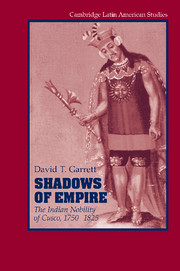Book contents
- Frontmatter
- Contents
- List of Illustrations
- Acknowledgments
- Pueblos Mentioned in Text
- Pueblos on Maps, by Province
- Introduction
- Part I INDIAN ELITES AND THE COLONIAL ORDER
- Part II THE INDIAN NOBILITY OF BOURBON CUSCO
- 3 Cacical Families and Provincial Nobilities
- 4 Communal Economies and Indian Fortunes
- 5 The Politics of the Cacicazgo
- Part III CRISIS AND COLLAPSE
- Conclusion
- Appendix
- Glossary
- Bibliography
- Index
5 - The Politics of the Cacicazgo
Published online by Cambridge University Press: 19 October 2009
- Frontmatter
- Contents
- List of Illustrations
- Acknowledgments
- Pueblos Mentioned in Text
- Pueblos on Maps, by Province
- Introduction
- Part I INDIAN ELITES AND THE COLONIAL ORDER
- Part II THE INDIAN NOBILITY OF BOURBON CUSCO
- 3 Cacical Families and Provincial Nobilities
- 4 Communal Economies and Indian Fortunes
- 5 The Politics of the Cacicazgo
- Part III CRISIS AND COLLAPSE
- Conclusion
- Appendix
- Glossary
- Bibliography
- Index
Summary
The most lucrative and powerful position in the Indian republic, the cacicazgo was the object of considerable competition and conflict. As all cacicazgos ultimately fell in the crown's gift, corregidor and audiencia courts presented an obvious venue for battles between a community's rival claimants or factions. Such complaints and lawsuits offer an important window into pueblo politics, and have not gone unnoticed by historians. Focusing on the cacicazgo as the nexus between Spanish and Indian society, scholars have viewed accusations by “indios del común” of abuses by their cacique, or the appointment of an illegitimate cacique by the corregidor, as testimony not only against individuals, but also against the corrosive effects of Spanish colonialism. Complaints of land usurpation and excessive demands for labor by caciques highlight how the emergence of an Andean form of market capitalism, and the co-option of indigenous elites in the exploitation of the Indian peasantry, created class conflict within the pueblo. Spanish interference in cacical appointments underscores the erosion of local autonomy within Indian society, and hence Spanish disregard for material and power relations understood as legitimate within Indian communities. Joining dependency theory and studies of moral economy, these works have exposed how Andean commoners challenged local aspects of Spanish imperialism and actively sought redress.
While legal and physical conflict – invariably charged with the rhetoric of illegitimacy and abuse – were a constant of colonial Andean society, in the past two decades scholars have focused on the period from 1740 to 1780, analyzing local unrest in the Indian republic to elucidate loci of conflict, and indigenous political ideals and strategies, in the decades preceding the Great Rebellion.
- Type
- Chapter
- Information
- Shadows of EmpireThe Indian Nobility of Cusco, 1750–1825, pp. 148 - 180Publisher: Cambridge University PressPrint publication year: 2005



